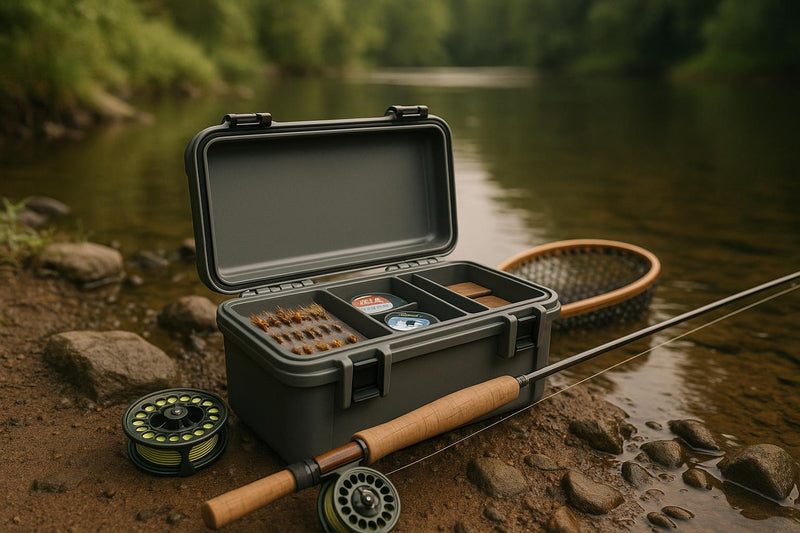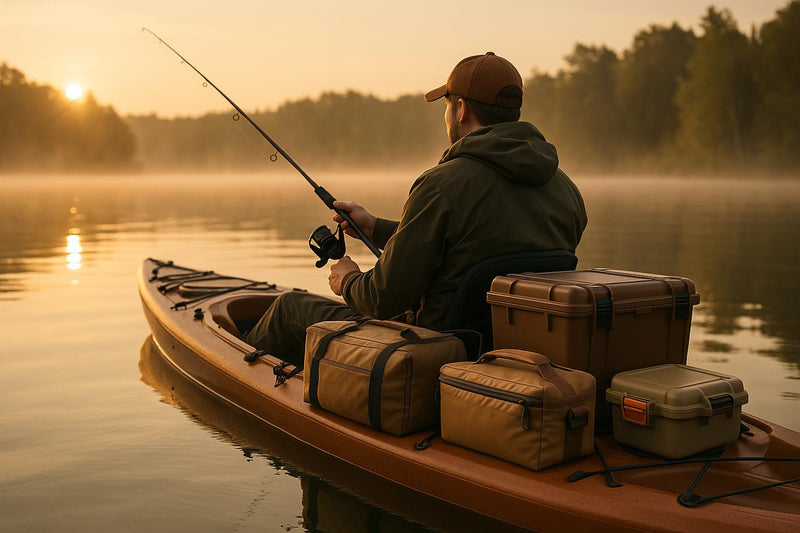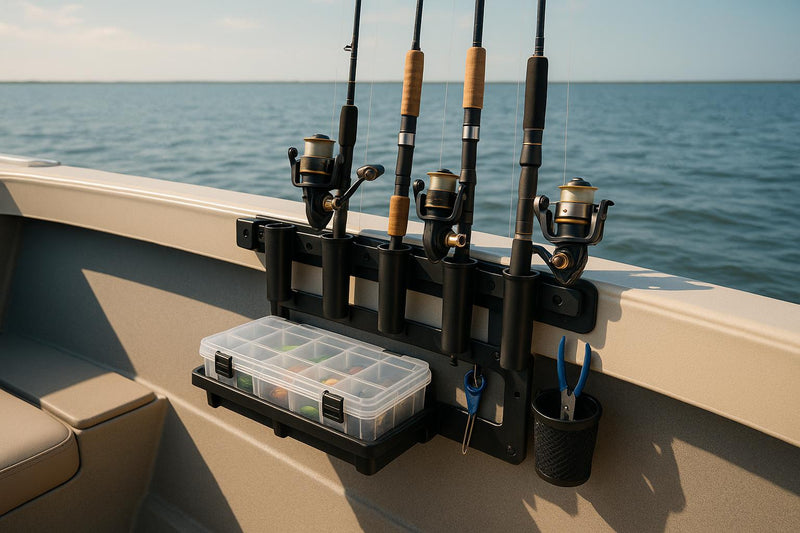Eco-friendly solar rail storage systems for fishing boats offer a dual solution: secure storage for electronics and renewable energy generation. These systems convert unused rail space into a power source using solar panels and built-in batteries, eliminating the need for disposable batteries or noisy generators. Benefits include:
- Renewable Energy: Solar panels generate clean power, reducing reliance on fossil fuels and lowering operating costs.
- Silent Operation: Unlike generators, these systems operate quietly, preserving the tranquility of fishing trips.
- Durable Materials: Built with recyclable and corrosion-resistant materials like aluminum and FRP composites for longevity.
- Cost Efficiency: Though the initial investment is higher, long-term savings come from reduced fuel and battery expenses.
- Ease of Installation: Clamp-on brackets and pre-wired components simplify setup, often taking just a few hours.
Solar rail storage also powers essential devices like GPS units and fish finders, ensuring safety and performance during long trips. With advanced features like tilt-adjustable panels and lithium-ion batteries, these systems are a practical upgrade for anglers looking to reduce their environmental footprint while enjoying reliable power on the water.
Green Benefits of Solar Rail Storage
Solar rail storage systems represent a smart way to harness renewable energy while minimizing environmental impact. By utilizing solar power directly on board, these systems not only reduce the carbon footprint of recreational fishing but also support efforts in marine conservation.
Reducing Fossil Fuel Dependency
Traditional power sources like gasoline generators and disposable batteries come with significant downsides: carbon emissions, potential fuel spills, and environmental hazards. Solar rail storage systems, on the other hand, deliver clean power with zero emissions. By eliminating the need to store and transport gasoline, these systems reduce spill risks and contribute to a cleaner, healthier marine environment. This environmentally conscious approach also extends to the materials and components used in these systems.
Recyclable and Durable Materials
Solar rail storage systems are designed with sustainability in mind, often utilizing durable and recyclable materials. A standout example is aluminum alloys, which are both lightweight and endlessly recyclable.
"Aluminum's recyclability is in line with current environmental trends. It can be recycled an unlimited number of times without losing its inherent physical and chemical properties like other materials. For projects pursuing green building certification, aluminum brackets are an environmentally friendly choice."
- Soeasy (Xiamen) Photovoltaic Technology Co., Ltd.
Aluminum’s lightweight nature (2.7 g/cm² compared to steel’s 7.8 g/cm²) makes it a practical choice for solar rail systems, simplifying installation and improving vessel handling. For added structural support, galvanized steel is often used, with its protective zinc coating extending the system's lifespan. In specialized cases, Fiber-Reinforced Polymer (FRP) composites provide exceptional corrosion resistance, lightweight durability, and non-conductivity.
Here’s a quick comparison of the key materials:
| Material | Weight | Recyclability | Corrosion Resistance |
|---|---|---|---|
| Aluminum Alloys | Light (2.7 g/cm²) | Unlimited recycling | High |
| Galvanized Steel | Heavy (7.8 g/cm²) | Recyclable | Medium-High |
| FRP Composites | Very Light | Moderate | Very High |
Less Waste Through Rechargeable Batteries
Another way solar rail storage systems contribute to sustainability is by reducing battery waste. Unlike traditional disposable batteries, these systems rely on Li-ion batteries, which generate far less waste. Advanced battery management systems optimize charging cycles, extending battery life and reducing hazardous waste. Additionally, battery recycling programs help reclaim valuable materials, further cutting down on waste. With a typical lifespan of 20 to 25 years and minimal maintenance, solar rail systems present a long-term, eco-friendly solution.
For anglers who want to upgrade their experience on the water, there are also premium gear options to consider. For example, Reel Comfort offers Fishing shorts and Mens Fishing Shorts that combine comfort, durability, and style - perfect for those extended fishing trips.
Key Components and Installation Process
Getting familiar with the key parts and installation steps of solar rail storage systems can help anglers make smarter choices when upgrading their boats with renewable energy. Designed with simplicity in mind, these systems are accessible even for those without technical expertise. This breakdown also ties back to earlier discussions on the environmental and practical perks of these systems.
Core Components of Solar Rail Storage Systems
Solar rail storage systems are made up of components that work together to capture, store, and distribute energy. At the heart of the system are solar panels, built with high-efficiency cells that convert sunlight into electricity. These panels are designed to endure the harsh marine environment, with mounting brackets securing them to your boat’s rails. These brackets ensure the panels stay in place while resisting damage from saltwater and UV exposure.
A charge controller manages the power flow to prevent overcharging the batteries, which are typically lithium-ion batteries known for storing energy efficiently. The system also includes an inverter to convert the stored direct current (DC) into alternating current (AC), allowing you to power onboard electronics. To keep you informed, monitoring systems provide real-time updates on energy production and the system’s overall performance.
For safe operation in challenging marine conditions, the setup uses marine-grade wiring and waterproof connectors to protect against corrosion and water damage.
Simple Installation Process
One of the best features of solar rail storage systems is their easy installation, which usually requires minimal changes to your boat. Clamp-on mounting brackets attach directly to standard rails without the need for drilling. These brackets slide onto the rails and are secured with stainless steel clamps, creating a stable base for the solar panels.
Pre-wired harnesses make connecting the panels to the charge controller a breeze. The controller then connects to the battery bank through clearly marked positive and negative terminals. Most manufacturers include detailed installation guides with step-by-step photos and troubleshooting tips. In most cases, you can set up a basic system in just 2–4 hours, making the upgrade process quick and hassle-free.
Adjustable Designs for Anglers
Modern solar rail storage systems are designed with flexibility in mind, catering to different boat rail sizes and fishing needs. Many systems feature tilt adjustment mechanisms, allowing you to angle the panels toward the sun for improved energy capture. Tilting the panels instead of leaving them flat can boost efficiency by up to 25%.
Some systems also include telescoping rails that can extend or retract to fit various rail lengths, while swivel mounts let you rotate the panels horizontally to follow the sun’s movement. These adjustable features ensure the system works efficiently without interfering with fishing activities.
For anglers who want to enhance their overall comfort during long trips, pairing solar rail storage with high-quality gear can make a noticeable difference. For instance, Fishing shorts designed for marine use provide both durability and comfort, perfectly complementing the sustainable benefits of solar-powered systems. Investing in reliable Mens Fishing Shorts can make those extended hours on the water much more enjoyable.
Cost Savings and Efficiency of Solar Rail Storage
Let’s break down the financial and practical advantages of using solar rail storage for your boat. While the upfront cost may seem steep, the long-term savings and reduced maintenance make it a worthwhile investment.
Initial Costs vs. Long-Term Savings
Solar rail storage systems rely on components like solar panels, high-capacity batteries, charge controllers, inverters, and marine-grade hardware. At first glance, the cost may feel like a hurdle. However, by eliminating recurring expenses like marina electrical fees, you’ll see significant savings over time. Plus, these systems are built to last. High-quality solar panels and batteries require minimal maintenance - mostly occasional cleaning and basic checks - resulting in fewer replacements and lower ongoing costs. Beyond the savings, they support a cleaner, greener way to enjoy boating.
Energy Efficiency Ratings and Performance
Marine solar panels are specifically designed to harness sunlight and convert it into electricity efficiently. Paired with smart battery management systems, they ensure optimal charging and power delivery - even in less-than-ideal weather. This means you can count on a steady energy supply to keep your onboard electronics running smoothly, no matter where your adventures take you.
Comparison Table: Solar vs. Standard Storage
Here’s a quick look at how solar rail storage stacks up against traditional storage options:
| Feature | Solar Rail Storage | Standard Electric Storage | Manual Storage |
|---|---|---|---|
| Initial Cost | Higher upfront investment | Lower upfront cost | Minimal initial investment |
| Monthly Operating Cost | Minimal or none | Recurring energy or hookup fees | None |
| Energy Independence | Operates independently of shore power | Dependent on external power sources | No electrical supply |
| Maintenance | Low, with occasional cleaning and checks | Requires more frequent servicing | Routine manual care |
| Lifespan | Built for long-term use | Moderate lifespan with regular upkeep | Shorter overall lifespan |
| Weather Dependency | Performs well in variable conditions | Often reliant on optimal conditions | Generally unaffected |
| Noise Level | Silent operation | May produce operational noise | Silent |
| Environmental Impact | Eco-friendly with reduced emissions | Relies on grid or non-renewable energy | Minimal impact |
| Payback | Recoups investment over time | Ongoing costs can add up | Immediate cost benefits |
The table paints a clear picture: while manual storage may win on initial affordability, it falls short in efficiency and convenience. Standard electric options, though familiar, often come with recurring costs that chip away at their appeal. Solar rail storage, on the other hand, offers a quiet, eco-conscious, and cost-effective solution - especially for anglers heading to remote locations or planning extended trips.
Switching to solar rail storage is a smart move, much like investing in premium Fishing Shorts or Mens Fishing Shorts for ultimate comfort and durability. Both choices deliver long-term value and performance that make them worth every penny.
sbb-itb-cb0a783
New Developments and Best Practices for Solar Rail Storage
The latest advancements in solar rail storage are making waves, improving efficiency, durability, and ease of use. These upgrades are not only transforming boat power systems but also aligning with eco-friendly practices.
Recent Technology Advances
Marine solar technology has taken a leap forward with cutting-edge features designed to boost performance and sustainability. For instance, bi-facial solar panels harness sunlight from both sides, benefiting from water reflection to capture more energy. Meanwhile, lithium iron phosphate (LiFePO4) batteries have become a game-changer, offering more charge cycles, quicker charging, and lighter weight compared to traditional lead-acid batteries. Modular rail systems now allow anglers to easily customize setups with plug-and-play components, tailoring the system to their needs. On top of that, smart charge controllers equipped with Maximum Power Point Tracking (MPPT) technology ensure consistent peak efficiency by adapting to changing light conditions. Together, these innovations create a solid foundation for optimizing solar systems.
Best Practices for Maximum Efficiency
To get the most out of your solar system, a few practical steps can make a big difference. Start with proper panel positioning - aiming for maximum sunlight exposure - and clean the panels regularly to remove salt and debris that can reduce efficiency. When it comes to batteries, avoid extreme charge levels; keeping them at moderate levels ensures better longevity and performance. Use battery monitoring systems to track key metrics and prevent overcharging. Additionally, invest in marine-grade cables that are properly sized to minimize power loss, and ensure there’s adequate ventilation for controllers, inverters, and battery compartments to prevent overheating.
How Solar Storage Works with Angler Comfort
Beyond the technical advancements, solar storage enhances the fishing experience in ways that anglers will appreciate. It powers essential gear like fish finders, GPS units, lighting, coolers, and fans, ensuring comfort and convenience during long trips - even when shore power isn’t an option. Plus, the silent operation of solar systems creates a tranquil environment, perfect for a peaceful day on the water. Pair this with premium Men’s Fishing Shorts designed for all-day wear, and you’ve got a setup that supports both comfort and sustainability. Just as those fishing shorts shield anglers from the elements, solar rail storage provides reliable, eco-friendly power to keep the journey smooth and enjoyable.
Conclusion and Recommendations
Key Takeaways for Anglers
Solar rail storage systems offer a renewable energy solution that’s perfect for modern fishing trips. They provide a cleaner, more cost-effective way to power your boat, balancing eco-consciousness with long-term savings, even if the initial investment is higher. Thanks to advancements in solar technology, these systems are now more efficient and reliable, making them ideal for running crucial boat electronics.
But it’s not just about powering your boat - solar storage systems can elevate your entire fishing experience by ensuring you have the energy you need, when you need it.
Blending Sustainability with Comfort
A successful fishing trip isn’t just about the gear you bring; it’s about combining eco-friendly innovations with practical comfort. Solar rail storage systems take care of your boat’s energy needs, while premium fishing shorts ensure you stay comfortable on the water. Designed with water-resistant materials and ergonomic features, these men's fishing shorts are built to keep you focused on what matters - enjoying your time outdoors.
FAQs
How does the cost of solar rail storage compare to traditional power sources over time?
While the initial cost of solar rail storage systems tends to be higher than that of traditional power sources, they can lead to substantial savings over time. In fact, solar technology has become much more accessible in recent years, with the price of solar panels dropping by more than 65% since the early 2000s. This downward trend in costs makes solar a financially smarter option in the long term.
Beyond the financial advantages, solar rail systems also come with added perks like lower maintenance costs, reduced energy bills, and a smaller environmental footprint. Plus, they promote energy independence. Over time, the upfront investment proves worthwhile, combining sustainable energy solutions with economic benefits.
How do solar rail storage systems benefit the environment when used on fishing boats?
Solar rail storage systems on fishing boats bring a cleaner, greener approach to fishing operations by reducing the dependence on fossil fuels. By tapping into solar energy, these systems operate without producing direct emissions, which helps shrink the carbon footprint tied to fishing activities.
On top of that, they contribute to reducing water and air pollution, creating a healthier environment for marine life. This shift toward cleaner energy supports more sustainable fishing practices, paving the way for a healthier ocean and a better future.
How do solar rail storage systems perform in different weather conditions during fishing trips?
Solar rail storage systems are built to last, crafted from tough, weather-resistant materials like marine-grade aluminum and sealed solar panels. This rugged design shields them from tough conditions - think heavy rain, strong winds, or even saltwater exposure - so they stay dependable no matter the environment.
With their corrosion-resistant construction and ability to perform in extreme temperatures, these systems deliver steady energy to power your electronic devices. Whether you're out fishing under a blazing sun or braving unpredictable weather, they keep your gear running without a hitch, adding efficiency and a touch of eco-consciousness to your adventures.




